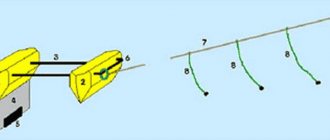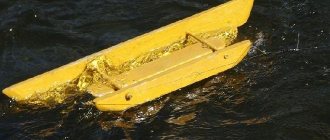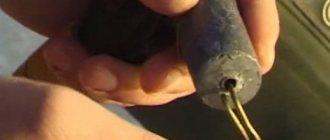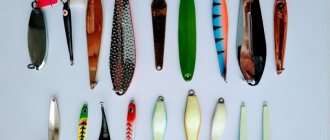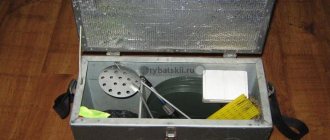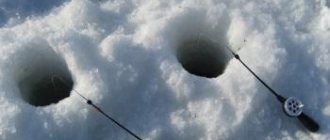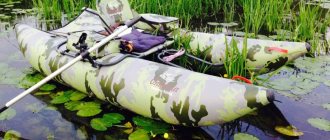Homemade hook.
I have long set out to make a hook that would be lightweight and fit into a winter box. Before that, there were long hooks - you had to fasten them to a drill, which is not very convenient. Buying from a store is also not an option - you would have to shorten them - why bother with unnecessary movements. I've had them lying around for a long time telescopic stands for fishing rods - that's what you need - I looked in the bins - I found handles and tubes and everything I needed for making - half a day and two hooks are ready. And now, in order:
I need a telescopic stand for a fishing rod - the handle can be made from any wood -or other dense material by drilling a hole along the diameter of the tube.
We bend the hook from a motorcycle knitting needle or elastic wire. I used the handle from an old spinning rod, having previously adjusted the hole to the diameter of the tube. Next, we cut everything to the required size
We drill a hole in the plug and pass the cord through, after placing the cambric inside, we knit it into a knot and burn it a little, then we put the plug on the handle with glue.
Next, we fix the hook in the retractable tube and the hook is ready.
When folded, the length is 45 cm, when unfolded it is up to 80 cm - you can set the length within these limits to whatever you need - the screw securely fixes it.
I still have a short part of the tube left from the stand - I found a suitable tube for it from an old pendant lamp and a handle from a soldering iron - it would be a sin not to make another hook - smaller - so that it would fit into a small box. I drove one part of the tube with threads and holes for the wires into the handle and placed it on the glue - I drilled the blind clamping plug through the diameter of the retractable tube and on the side, after tightening it, I drilled a hole for the M4 thread
The cork from a bottle of valerian fit perfectly under the cord; I placed it on liquid nails in the handle.
And then we refine the hooks - as best we can and everything is done. It took me about an hour to make the first one. The second one, taking into account the selection of materials, took a little more. I checked all the connections for rupture, but it was not possible to pull them out.
And be sure to make plugs on the tip from a thick-walled rubber tube.
You can use it even for winter fishing or summer fishing - it fits perfectly in any bag and does not take up much space. The weight is small 145 grams - which is larger than 200 grams, which is not particularly noticeable.
The hook is indispensable when fishing from a steep bank - you can drag it onto a flat bank. But this cannot be done on a step. Carrying a landing net with you is cumbersome and inconvenient - and the hook can be brought into working condition in a second and the trophy will not set sail to its native element.
Well, the price of the issue is 70 rubles for a stand + a minimum of hassle versus more than 400 for a store-bought one.
Hook for fishing: purpose, types, making your own
Types of hooks
Buy quality products at affordable prices from the best fishing online stores. Give gifts to yourself and your loved ones!
Summer hooks reach a length of 1.5 meters, but winter hooks are shorter than long.
This fishing attribute is always present among winter fishing enthusiasts, and especially among those who practice catching predators. Without a hook it makes no sense to go fishing at all. The fact is that pulling a large fish out of a hole is quite problematic, especially with bare hands, and even in the cold.
Without this simple device, it is difficult to cope with predators such as pike, pike perch, burbot, etc. in winter. The hook is also useful when fishing for large perch, carp, bream, etc. The mechanism of hooking is as follows: when the fish is already in the hole, it is caught with a hook on the lower jaw or gills.
Hook device
The general design of the hook can have a variety of designs, but its principle of operation is almost the same, which indicates the presence of a standard part. Any hook design consists of 2 main parts: a handle and a working part. The main material for making a handle is wood such as birch, ash, beech, maple, oak and others.
The design of the handle is of no small importance, as is the quality of its manufacture. It must be carefully sanded and coated with water-repellent varnish or paint.
A primer, which is rougher than enamel, will also be used for coating. The color of the coating is, of course, dark, so that the hook is easy to find in the snow. Naturally, it is not recommended to use metal to make a handle. In the cold, and even with water, your hands will instantly freeze to the instrument, even if they are wearing gloves. The working part of the hook is a metal hook made of steel wire, about 5 mm thick. A large fishing hook for catfish is suitable for making a hook.
Buying store-bought is also not an option - you would have to shorten it - why the extra body movements.
and now we glue the tube with the clamp into the handle. Next, we fix the hook in the retractable tube and the hook is ready.
- When folded, the length is 45 cm, when unfolded it is up to 80 cm - you can set the length within these limits to whatever you need - the screw securely fixes it.
- I still have a short part of the tube left from the stand - I found a suitable tube for it from an old pendant lamp and a handle from a soldering iron - it would be a sin not to make another hook - smaller - so that it would fit into a small box. I drove one part of the tube with threads and holes for the wires into the handle and placed it on the glue - I drilled the blind clamping plug through the diameter of the retractable tube and on the side, after tightening it, I drilled a hole for the M4 thread
- The cork from a bottle of valerian fit perfectly under the cord; I placed it on liquid nails in the handle.
And then we refine the hooks - as best we can and everything is done. It took me about an hour to make the first one. The second one, taking into account the selection of materials, took a little more. I checked all the connections for rupture, but it was not possible to pull them out.
You can use it even for winter fishing or summer fishing - it fits perfectly in any bag and does not take up much space. The weight is small 145 grams - which is larger than 200 grams, which is not particularly noticeable.
The hook is indispensable when fishing from a steep bank - you can drag it onto a flat bank. But this cannot be done on a step. Carrying a landing net with you is cumbersome and inconvenient - and the hook can be brought into working condition in a second and the trophy will not set sail to its native element.
Well, the price of the issue is 70 rubles, a stand with a minimum of hassle versus more than 400 for a store-bought one.
The hook is made of a stainless steel rod with a diameter of 5 mm. The length of the entire hook is 66 cm. The length of the tip is 9 cm. The tip should be sharpened before you start making a bend. You can do it after, but it will be more difficult to work with sandpaper. I made the jumper by welding. If you don’t have a welding machine, then you can get by with cold welding.
The bend for the handle should be bent in the direction opposite to that in which the tip is bent. As a result, we will have an excellent fulcrum for the fingers, and the gaff will lie very comfortably in the hand.
Read: Catching perch on the first ice
Next, we wrap the handle with a piece of foam rubber and winding material, for example, electrical tape. The hook is ready to use.
When fishing along the shore, I wear a hook in my belt. The volumetric handle will never allow it to fall out without permission.
At the same time, I always easily reach it with one hand and with one movement of my index finger I remove the cap from the sting. The handle can be covered with heat shrink. Preferably bright colors to make it easier to see on the ground and grass.
Purpose of the hook
The good thing about the hook is that both in the finished and assembled state it is smaller than a landing net. Among other things, in this case there is no limit on the maximum size of the fish. But if you do catch-and-release fishing, this option is not suitable for you. The summer hook is about 1.5 meters long. If you are fishing by wading, it is better to choose a shorter option.
Bagoriks used in winter are shorter. In winter, there is no alternative to the product; landing nets cannot be inserted into the hole. And a do-it-yourself hook will make fishing convenient.
Separately, it is worth highlighting products intended for white fish. They have a lighter design. The presented version is very short. It is needed in order to pull out the fish when it is in close proximity to the hole. The handle should provide positive buoyancy.
The division of gaffs into summer and winter can be called conditional. In fact, any product can be used at any time. Also, hooks can be solid or include a number of elements.
Types of hooks
The hooks are used during wading fishing for large predators, during the “hunt” for large fish, and during sea fishing.
- The folding hook has two parts. They are connected to each other by a special hinge. The principle of operation is very simple, the product is set in motion with one movement of the hand. This is a winter option that fits perfectly in a fishing box.
You may be interested in an article about an ice fishing box.
- The design of the flexible hook is interesting. Its body consists of several elements through which a steel cable is threaded. The product is activated using a handle with a tension device. The hook can be rolled up when you do not intend to use it. When tensioned, the structure becomes quite rigid. The cost of the products is quite high.
- Telescopic hook. The design allows you to hold the product in different positions. It folds quickly and allows sections to be secured in intermediate and fully extended positions. This is mostly a summer option. If you attach a hook to the shaft, you can change attachments.
How to make a hook on your own
What are the requirements for a do-it-yourself hook? The handle should not slip. The product should be easy to disassemble and assemble, and fit in a fishing box.
The point is only sharp, and a special device should be placed on it, which will release the hook if it gets caught.
- Take two elbows slightly shorter than the length of the box.
- The handle can be made from a previously dried cherry branch. Length – about 26 cm, diameter – 23 mm. It is best to make a thickening at the end so that the holder does not slip out. Be sure to cover the handle with primer.
- A hole with a diameter of 4 mm is drilled at the end of the handle. A ring of aluminum wire is mounted into it.
- At the bottom of the handle, the end of a steel pin is inserted into the hole - the diameter is 5 mm, the length is about 19 cm. The pin is attached to the handle with a clamp.
- At the other end of the pin there is an M5 thread cut, a coupling will be screwed onto it - length 45 mm, thread also M5. It is wrapped on the lower pin of the hook, which is made of thick wire - diameter 5 mm, length 360 mm. Fix the coupling on it using an M3 screw. The bent end of the lower pin is 75 mm long. The bending radius is 15 mm. Sharpening – 45 mm cone.
- The last stage is to install a fork with your own hands, which will help unhook the hook of the jig. To do this, a wire with a diameter of 1.8 mm and a length of 30 mm is attached to the bend of the lower pin. The wire is wound around the knee. There should be 3 turns. So, you have a fork into which you will place the fishing line.
A hook is a device designed to make it easier to pull fish out of the water while fishing. At the same time, there are several types of products, each of which has its own advantages.
But the best device will be the one you made yourself, “for yourself”; it will be very convenient to use.
Do-it-yourself hook for winter fishing - instructions, drawings, assembly tips
Fishing is a creative process based on luck. The catch can be completely unpredictable - either it is a small crucian carp or it is a catfish weighing over 10 kg. If there are no problems with catching small fish, then the large fish, which the angler dragged with his tackle to the shore or to the hole, somehow needs to be pulled out.
A gaff helps solve this problem. If in summer you can take it with a landing net or with your hands, then in winter there is no alternative to a hook. There are two types of gaffs - summer and winter. Summer hooks are more powerful and longer. Their length is about 1.5 meters. Winter gaffs are shorter and more delicate.
Do-It-Yourself Ice Fishing Hook
Hood for winter fishing
with your own hands
Fishing is an unpredictable process, depending on what size fish will bite. You might like a small fish, weighing 100 grams, or a large specimen, the weight is usually 10 kg, but saving is not easy. Catching a small fish does not come with any surprises, but catching a large specimen is fraught with uncertainty in its own capabilities. This is especially important when the fisherman did not personally take a special device. It is difficult to drag a large fish even to the shore, but taking it out onto the shore is a whole problem. You, in the summer, fishermen use landing nets, but in the winter, you can’t pull out fish unless you use a hook. Therefore, hooks are divided into summer and winter ones. Summer hooks reach a length of 1.5 meters, but winter hooks are either short or long.
Purpose of the hook for fishing
Bagorik is an integral attribute of winter fishing. Any self-respecting angler who catches a predator on the ice in winter will not go fishing without a hook, for the simple reason that pulling a good catch out of a hole with bare hands is very problematic, and sometimes even impossible.
Without a hook it is almost impossible to pull out such predators as pike, pike perch, and burbot. Also, when fishing for bream, carp and perch, it is better to try to use a hook. The hooking technique is as follows: when the fish is brought with its head into the hole, it is hooked with a hook to the lower jaw or gill.
Why a hook for fishing
> the myth of the fishing attribute is always found among lovers of winter fishing, and especially among those who practice catching predators. Without a hook, it’s not a good idea to go fishing at all. It is true that removing a large fish from a hole is quite problematic, especially with bare hands, and even in the freshest air.
Without this usual device, it is difficult in winter to cope with such predators as pike, pike perch, burbot, etc. The hook will not be needed when fishing for large perch, carp, bream, etc. The mechanism of hooking is the following: when the fish is already in the hole, it is caught with a hook by the lower jaw, or, in other words, by the gills.
And the most important thing is that the hook should be strong and not let the fisherman down at the most crucial moment; moreover, the hook should not take up much space and fit easily into the fishing box. Here, the hook is made collapsible, which is not feasible more conveniently.
Hook device
The designs of hooks can be varied, but, as a rule, their general structure is the same. Any hook consists of the following components:
- Lever. Typically, the main material for making a hook handle is hard wood - maple, ash, oak, beech, birch, etc. The handle should be well sanded and painted with a water-repellent coating. It is better to use a primer as a coating, as it is rougher than enamel. The color of the primer should be chosen darker so that the gaff is better visible on snow or ice. Metal can also be used as a material. But this material is less practical due to its weight.
- Working part. The main working part of the hook is a metal hook, which, as a rule, consists of steel wire with a diameter of 5 mm or a large fishing hook for catfish.
How to make a hook for ice fishing with your own hands
Of course, like any fishing accessory, a hook can be bought in a store, but making it yourself and thereby being confident in its reliability is a more acceptable option for a real fisherman.
How to catch more fish?
So, what materials and accessories may we need to make a winter hook with our own hands:
- Wooden blank for a cylindrical handle 20-30 cm long with a diameter of 25 mm;
- Steel wire or pin with a diameter of 5 mm and a length of up to 1 m;
- Car clamps;
- 2 washers;
- Large catfish hook;
- Welding machine;
- Bulgarian;
- Drill;
- Dark wood primer.
Types of hooks for fishing
Of course, in our modern times, the variety of fishing tackle and accessories is very large. The hook, as a fishing accessory, is no exception. In addition to the fact that they are divided into summer and winter, there is another classification of gaffs - transformable and non-transformable, that is, solid. Transformable subspecies include:
Having caught 237 kg of fish, the poachers were not punished!
During interrogation, the detained fishermen revealed the name of the secret bait.
Folding hook
Lightweight and compact version of the hook. As a rule, it consists of two parts, which are connected to each other by hinges. It can be brought into working position very easily with the movement of one hand.
Flexible hook
This option consists of many components that have an internal longitudinal hole and are made of lightweight stainless materials.
A steel cable with a diameter of about 3 mm runs inside these components. A tensioning device is installed on the handle - the cable is tensioned and the components take on a rigid and durable structure. This is one of the most expensive types of gaffs.
Telescopic hook
This version of the hook is good because it has a design that allows it to be held in any position. Sections can be extended completely or partially, as a result of which its length can be adjusted. As a rule, such hooks are summer options.
Varieties of hooks
Although at first glance the hook seems to be a primitive tool, there are many options for its manufacture. Some of the most popular are flexible, folding, and telescopic hooks.
Flexible gaff
Such a hook consists of several parts connected by a cable. When the cable is relaxed, the working part becomes flexible. But as soon as you press and activate the tension device on the handle, the handle will align and take its normal shape.
Folding gaff
This specimen is very similar in design to a folding fishing rod or spinning rod. When assembled, it takes up minimal space and fits into your pocket without any problems. Usually consists of two parts, but there are models with more links.
Telescopic gaff
Most often this tool is used for summer fishing. Its distinctive feature is that its length can be controlled, and if desired, you can get a full-fledged one and a half meter instrument.
Rules for using a hook for winter fishing
Of course, when there is a big fish on the hook, there is especially no time to think about how to use the hook correctly. You can’t waste a second, as the fish can get off the hook and get away. Nevertheless, there are some rules that can increase the likelihood of fish rising on the ice.
Let's list them:
- You need to remain calm and self-possessed; under no circumstances should you fuss or make unnecessary movements;
- The hook drops into the hole before the fish gets there;
- The place where the fish turns purple is the area of the front fins;
- The angler's movements should be as sharp and short as possible;
- If the fish is wider than the hole, then holding it with a hook, you need to widen the hole.
Pocket safety hook
In all centuries and times there has been no limit to the creativity of amateur fishermen. Let's give an example of a creative approach to making a hook.
To make such a hook we need:
- antenna from an old radio;
- several wine corks;
- large hook for catfish;
- some copper wire.
So, we take three or four wine corks. We make through holes in them along the plug with a diameter slightly smaller than the first elbow of the antenna. We put these plugs on the first leg of the antenna and the beautiful, elegant handle is ready.
We bite off the eye of the hook and solder the hook to the last elbow of the antenna, having previously cleaned the soldering area and treated it with acid. Next, we wrap the soldered hook with copper wire and re-solder this entire winding. The decorative and compact hook is ready for use.
How to make a hook for ice fishing
The fishing process is akin to playing roulette, when you are lucky enough to catch a couple of palm-sized crucian carp, and when you are lucky enough to catch a five-kilogram pike perch, and at such moments you need to have a device on hand that makes it possible to pull this miracle out of the water. In the summer this can be done either manually or with the help of a landing net; they rarely resort to hooks, but in winter it is possible to get fish out of an ice hole only by hooking it with a hook. Not everyone lives in a locality that has a specialized fishing store. In addition, some simply think that this is not an accessory worth spending money on. Therefore, many people have to make the gaffs themselves. In this article we will focus on how to make a hook for winter fishing with your own hands.
How to use the hook
Regardless of the design, the hook is needed for only one thing: to help the fisherman drag the fish through the narrowest place - the hole.
Before using it, the fish must be tired so that it does not make sudden jerks, and the head must be brought directly under the hole. The line should be kept tight, without giving the fish any slack. But you shouldn’t pull the tackle too hard, since the fish, even very tired, is always able to make a powerful jerk and get off. You need to release the hook into the water and carefully try to hook the fish under the gills. Once this has been done, there is no time to hesitate. You need to put the fish's head into the hole and carefully pull it out onto the ice. By completely pulling it out and tilting it away from the hole, you can unhook it from the hook.
A do-it-yourself hook for winter fishing can also be useful in summer. They can, for example, take pike when fishing on a boat with a high side. However, open water gives the fish much more room to maneuver, so it is still more advisable to use a landing net in the summer.
Source
Purpose of the hook for winter fishing
A hook for a fisherman in winter is an indispensable accessory. Imagine a situation where you are pulling a fish to the surface of the water, but you cannot get it out of the hole. Firstly, you are wearing gloves, and the water is icy, if you climb into the cold water with your bare hands every time, you simply won’t last long. Secondly, the ice around you is wet, the water in the ice hole may be low and you will have to kneel, which is also very problematic. There are third and fourth ones, but we think the first two reasons are enough to simply use a hook to hook a fish dragged to the hole by the lower jaw from the back or even by one of the gills and easily pull it out of the water. And do not forget that it is possible to pull carp or silver carp out of an ice hole with your hands, but in the case of predators such as pike, burbot or pike perch, you simply cannot do without a hook.
Features of the winter version of the box
To make fishing in cold weather enjoyable, an angler needs a multifunctional box. Firstly, the catch is stored in it, and secondly, fishing gear is stored reliably and easily. Finally, it is comfortable to sit on a chair in front of the hole.
Read: Do-it-yourself pike fishing
Each homemade box has its own characteristics.
Size
Anglers choose the height of the box to suit their height. Usually it is no more than 400 mm.
The internal volume depends on the planned catches and the amount of gear to be carried.
Material
It must be resistant to low temperatures and not afraid of snow and water. Do not collapse under the weight of a seated angler.
The following materials meet these conditions:
metal is a material with high strength, frost resistance, and attractive appearance. Among the disadvantages of products made from this material are: heavy weight, rapid cooling, therefore requiring insulation of the internal walls, high price;
- polystyrene foam is a lightweight material with high thermal insulation and easy processing. Products made of foam plastic require careful handling, as they are easily damaged;
- Wood and plywood are easy-to-process materials with high strength. Wooden products are not resistant to moisture and absorb odors, so after fishing, a box made of this material is dried.
Cover with seat
Sometimes the lids are made removable to make it easy to take the catch. For seating, insulation is made of foam rubber, polystyrene foam or construction foam, covered with moisture-resistant material. The seat should not absorb moisture.
Inner space
Inside the box is divided into functional compartments.
A window is made in the fish compartment. It is necessary to collect the catch. This compartment should be easy to clean.
The gear is placed on the lid. Elastic bands and clips prevent gear from getting tangled.
Some drawers have a compartment for a thermos and food.
Carrying
During winter fishing you have to move around a lot. Various methods are used for carrying: straps, handles. The method with skis is not common among fishermen, as it makes the box bulky and heavy.
Fishing boxes are here!
Hook device for winter fishing
Hooks may vary in appearance, but the integral parts of each should be:
- Working part. It is most often made of steel wire, bent at the end in the form of a hook, or is simply a large fish hook profiled for catfish.
- Lever. The most reliable handle will be one made from hard wood. It must be carefully sanded and it is best if water-repellent paint is applied to it.
- Float (rarely used). Very often the hook slips out of your hands and goes under the water. Therefore, to the handle, at the end farthest from the hook, you should attach a float on a small (10-15 centimeters) rope, so that the hook that slips out of your hands can be grabbed at the last moment by this rope with the float, or, even if it slips out, so that it does not went to the bottom.
Description and purpose of the device
When fishing in open water, large fish are traditionally caught in a landing net. However, this method is simply not applicable for winter fishing. And there is nothing worse for an angler than dragging a fish to the ice and then not knowing what to do. It is not always possible to get a large specimen into a hole right away, and reaching into cold water with your hand is not an option, especially if there is a heavy pike on the hook, the teeth of which can seriously injure you. It’s good if there are fishermen nearby who will help. If you are alone with a fish, only a hook will help you out.
The design of a hook for winter fishing is very simple. Traditionally it consists of two parts:
- working part;
- lever.
The traditional material for making the working part is steel wire or tube. The handle is usually made of hard wood: beech, ash, birch. The surface of the wood is carefully sanded, impregnated with a water-repellent compound and painted dark for better contrast with the snow. It is not recommended to make metal handles; this makes the structure heavier and is not very comfortable in the cold.
Making the handle
Handles for hooks can be made not only from wood.
For this, it is quite possible to adapt a plastic handle from an old fishing rod. The main thing is to securely fix the working part in it. This can be done by simply threading the wire through the handle and bending the wire from which the hook is made. The bend can be recessed or hidden inside the handle, you can use glue or threaded fasteners - there are a lot of options. The lightest handles are made from cork. This is quite a suitable material for making a pen. You will need several wine corks, you can even use corks of different sizes, this will give the handle some curvaceousness. All of them are drilled through and put on the wire, after which the wire is bent and recessed in the outer plug. All elements are fixed together with instant glue.
In the same way, you can use not only cork, but also fine-pored foam. You just need to remember that the glue may contain a solvent that can melt the foam. Therefore, you first need to carry out a test gluing. Designs with porous handles are also preferable because if the hook jumps out of your hands, it will not sink. Although before use it is better to conduct a buoyancy test at home.
Working part
The working part with the hook is the basis of the hook. She may be:
- non-removable;
- collapsible;
- telescopic;
- folding.
The easiest way is to make a fish pot with a non-separable working part. Essentially, it is just a piece of thick steel wire, bent with a hook and sharpened on one side and with a handle on the other. Such a device is very simple to make, but its fixed length is not always convenient. Ice on reservoirs in the middle zone can reach a meter thick, and carrying such a long tool is very inconvenient.
The collapsible working part makes the hook more convenient. It is usually made of two halves. The lower part is made of thick steel wire. One end of it is bent in the form of a hook and sharpened, and a thread is made at the other end. The upper part with the handle can be made of the same wire, or from a tube. The wire is threaded with the same thread as on the lower part, and both halves are connected with a threaded coupling.
If the upper part is made of a tube, then an internal thread is cut in the lower part, and the second half with a hook is simply screwed into the first. This design has its advantages over the non-separable design, since it is twice as compact. The disadvantages include the need to constantly check the tightness of the threaded connection and the risk of losing the coupling.
Read Fishing for perch with live bait
The telescopic hook is the most convenient. You can also make it yourself, using an old car antenna as a basis. To make it you will also need:
- hook for catfish;
- several identical wine corks;
- instant glue;
- drill;
- soldering iron
The hook must be soldered into the thinnest elbow of the antenna. It is preferable not to use a fishing hook, but to bend it from ordinary steel wire of a suitable diameter. On the other side of the antenna, several plugs are placed on its thickest elbow, in which through holes are made along its length with a diameter slightly less than the thickness of the antenna. By putting the plugs on one after another, the entire structure is fixed with instant glue. When folded, such a hook is very compact and light in weight. When stretched, it can withstand very heavy loads, but when subjected to lateral force, it easily crushes and breaks.


